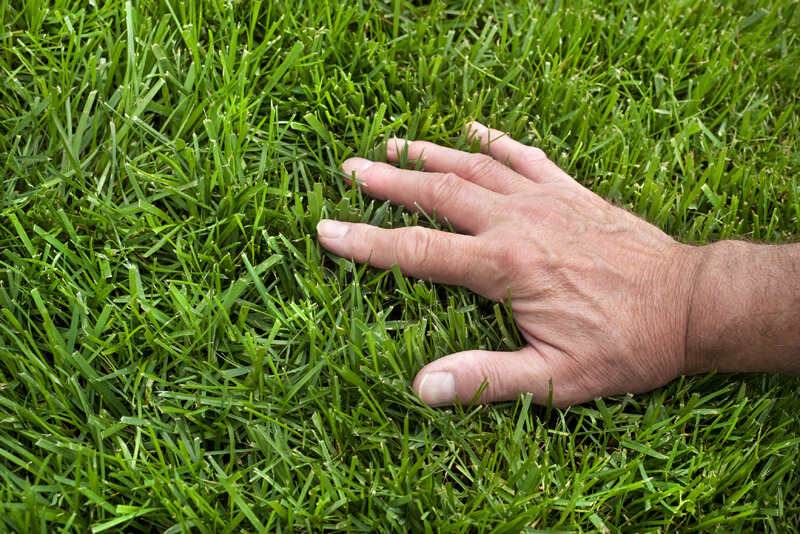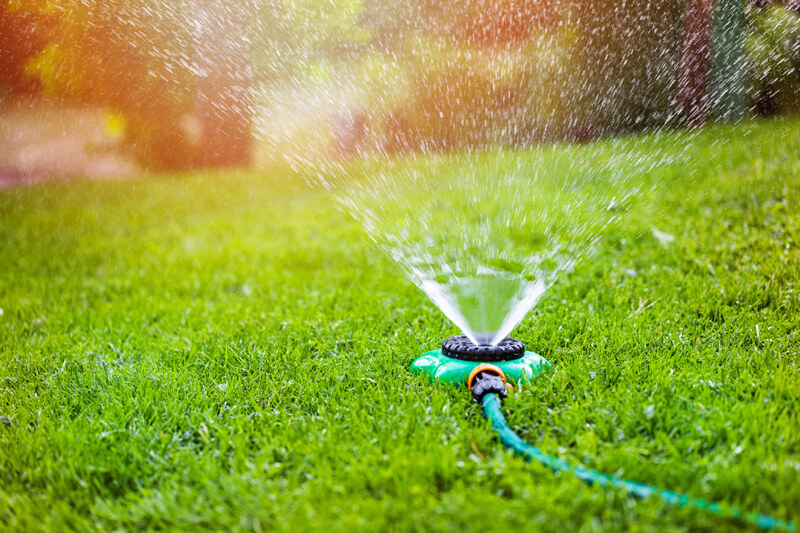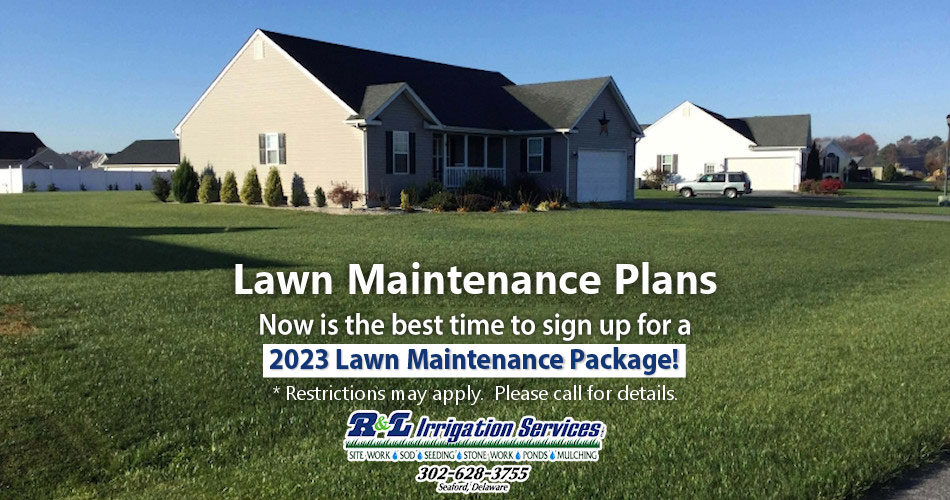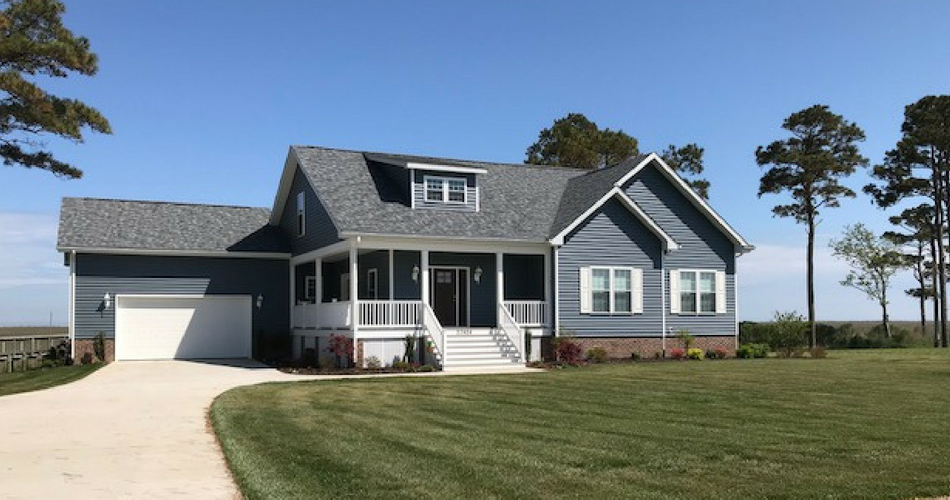
Benefits of Lawncare and Irrigation
Many people never give their lawn a second thought. The lawn is just something to be mowed every week or two, kept clear of leaves and debris, and at most occasionally reseeded or fertilized. However, this sort of thinking greatly underestimates the value – both financial and personal – that a well-maintained and healthy lawn can provide for homeowners. There are a number of benefits to a lush, green lawn besides just looking good, so make sure to give them healthy consideration this summer.
Lawns Keep Homes Cooler (…and Warmer)
It may seem strange, but trees aren’t the only thing that keep yards cool. All plants – including grass – help to keep outdoor spaces with greenery dramatically cooler than urban spaces without them. Grass absorbs sunlight in the process of photosynthesis, meaning that the much of the energy from the sun goes into the plant and its biological processes and not into a surface (like dirt or asphalt) where it will be absorbed and then released as heat. This summer, take note on a hot day of how much cooler a backyard lawn or garden is compared to a large parking lot. It is easy to feel the difference.
Plants also cool the environment by releasing moisture into the air through the process of transpiration. Transpiration is when the leaves lose moisture by evaporation – essentially the same process that turns a grape into a raisin. This allows lawns to act as a sort of heat reservoir, being cool in the warmer months and warmer in the cooler months. This is the same principle as the ocean cooling and warming effect, and is the same reason that coastal areas have much more moderate temperatures year round.
What all of this adds up to is astonishing. Grasses and other plants have a huge effect in urban and suburban spaces, lowering the temperature during the summer by between 2 and 22 degrees Fahrenheit. That means big savings on the energy bill, and a positive impact on the environment.
Lawns Promote Health and Wellness
Well maintained lawns don’t just make homeowners more comfortable, they also make them significantly healthier. For instance, many people are allergic to the pollen produced by common weeds such as ragweed, wormwood and fescue. Having some pollen outside is inevitable, but having the plants that produce the most irritating forms of it right outside the bedroom window means night after night of stuffed noses and sore throats. People with allergies routinely complain about the inability to sleep because of them. Cumulatively, that lack of sleep can cause significant health problems, ranging from loss of productivity to increased risk of heart disease. Healthy, thick grass leaves little room for weeds and produces virtually no pollen, dramatically reducing allergen exposure.
Even people without allergies can benefit hugely. Grasses and other plants have been demonstrated to absorb toxic substances and pollutants such as nitrogen oxides, formaldehyde, trichloroethylene, xylene, carbon monoxide, and benzene. In urban and suburban environments where pollution is a serious issue (or in areas where industrial farming releases a lot of pollution into the air, soil and water) a healthy lawn can be a big health boost. Homeowners should consider a healthy lawn to be an investment in their own health.

Lawns Help the Environment
Reducing pollution helps the environment, but that isn’t the only ecologically friendly benefit lawns have. All plants, including grass, are considered “carbon sinks.” That is, they absorb carbon dioxide from the atmosphere and release oxygen. The carbon is incorporated into the various organic materials that make up a plant, such as cellulose. Even when the plant dies, the organic materials are absorbed into the soil and stay fixed there for a very long time.
According to Madeleine Leslie of the University of Minnesota, “turfgrass actually has the potential to offset emissions by sequestering carbon dioxide…In this way, turf areas can sometimes be carbon sink for greenhouse gases rather than a source.” Leslie analyzed studies and found that home lawns can sequester more than 200 grams (about half a pound) of carbon for every square meter – and they do that every year. That means that even a small lawn could make a big difference over time, offsetting emissions and sequestering carbon to make a healthier planet for future generations to enjoy.
Lawns Improve the Property Value of Homes
The aesthetic and lifestyle value that a good lawn brings is not some abstract thing. It translates into very real and tangible improvements in property value. Curb appeal plays a massive role in how marketable a home is. It is not a coincidence that realtors and professional house flippers often hire expensive landscaping companies to help woo potential buyers. The investment pays off when the house is sold for a higher value than it would be otherwise.
Think about it this way: nobody would go to an important job interview without a clean haircut. Demonstrating basic care and maintenance is important in marketing anything. And when it comes to a home’s resale value, the lawn and yard is extremely important. Renovating the inside and outside of the home is one thing, but caring properly for a lawn is the first step in the correct direction. The lawn is the very first thing that potential buyers will see when they arrive. If a home doesn’t look good on the outside, those prospective buyers won’t even take the time to go inside and check it out. A home with fresh, green grass is inviting, and serves as an indication that the property as a whole has been taken care of well.
Lawns Reduce Noise Pollution
For those living in an urban environment, this one is absolutely crucial. Nothing is more frustrating than being woken up early by a distant car alarm or some other irritating city noise. Anyone who has lived in an urban apartment complex knows how obnoxiously loud it can get. All it takes to have a sleepless night is someone bouncing a basketball two blocks down the street.
That phenomenon happens in urban spaces because there is very little landscaping or lawn area between homes. Lawns act as a sort of soundproofing for the neighborhood. Due to their rough, varied shape and wide coverage, they help immensely to absorb noise from cars, neighbors, maintenance vehicles, and all the other annoying sounds of modern life. Open dirt, asphalt, concrete, and even gravel can reflect and amplify noises. Lawns and yards act to reduce noise pollution and improve quality of life. This is why forests and remote grassy fields have a serene, quiet feeling. Despite being full of birds and other wildlife, the sounds are fairly subtle due to the plant soundproofing that nature provides.
Lawns Help Prevent Soil Erosion and Reduce Runoff
When grass or other plants are healthy and vibrant, they grow a very extensive root system. The root system of those plants serves to bind the soil together, which stops it from getting washed away by rain, snowmelt, being watered, and prevents wind from blowing the soil away. While wind may not seem like a huge factor for erosion, remember that the Dust Bowl in the 1930s was caused almost exclusively by heavy winds and dry plowed topsoil with no plants to hold it down. Dust and sand storms have long plagued regions that do not (or can not) maintain plants to hold their soil down. Failing to maintain a lawn properly won’t cause a miniature Dust Bowl to happen in the back yard, but erosion can still be a big issue in many regions, and having a healthy lawn will help hold the soil down while also providing a good habitat for the plethora of beneficial organisms (such as ants and earthworms) that allow plants to have strong root systems in the first place. It is an upward spiral of benefits.
The other major benefit of cutting erosion, particularly water erosion, is that it dramatically reduces runoff. Stormwater runoff carries a lot of nasty pollutants, like fertilizers and pesticides, that can get into the municipal water system and cause big problems. Ultimately, the runoff may end up in the ocean, where it causes algal blooms and contributes to “dead zones” where fish and other sea creatures perish.
Lawns Help Prevent Fires
The threat of a house fire may seem distant and easy to ignore, but there are as many as half a million residential building fires in the United States every year, resulting in nearly 10,000 serious injuries and nearly 2,000 deaths. Even for those who escape a blaze unharmed, they are forced to watch as their home literally turns to ash before their eyes as they are helpless to stop it. In the best case scenarios, the damage costs tens of thousands of dollars to repair. In the worst case scenarios, there is nothing left to repair.
Fresh, green grass and a healthy landscape can cut the risk of a fire significantly. This works in two ways. First, the grass acts as a physical fire break. That is, it is a largely non-flammable space between two points that fire will not cross. Second, it serves as a wet and humid barrier to encroaching flames, protecting the home. The wet environment that health grass provides is essentially a moat of protection against fires. Compared to dry weeds, which are an excellent flammable fuel, healthy lawns offer serious protection against the threat of fire. However, maintenance is crucial. While a green, moisture-rich lawn can be a shield from fires, a dry and dead lawn may as well be a flaming sword shoved through the front door. Lawns filled with dry brush and dead grass can easily catch fire on a hot day. All it takes is one flicked cigarette from a neighbor strolling by, a grill to get knocked over, or a pit fire to shoot an ember in the wrong direction. In areas prone to wildfires, your lawn can even be the stopping point that buys the whole neighborhood time.
Lawns Reduce Stress and Provide Leisure
Many people work long hours at stressful jobs. And now that more and more people are working from home, the line between work and rest is increasingly blurry. The inside of your home may have once been a welcome sight and indicated that the working day was finished, but now it can carry the same stress that the office does. That is why it is so important to take a little bit of time away from obligations like work to relax, kick back, and enjoy a gorgeous lawn. Setting up a hammock or lawn chairs, setting up a croquet game, kicking around a soccer ball or playing with the kids in the grass – all of it can be an immensely joyful escape from the daily work we have to do. Check out ideas for do it yourself lawn games that are fun for the whole family
In fact, many studies have demonstrated that spending time in (or even simply looking at) natural environments with grass, trees, or water decreases the hormones associated with stress, like cortisol. The modern world is inundated with screens and increasingly connected, so just taking a minute to look at a nice lawn can be hugely relaxing. Exercise and socializing with friends and family on the lawn is also a great way to destress. They are the perfect place for picnics, barbeques, and other social events.
Increases Safety and Reduces Risk of Burglars
Ever heard of the “broken windows” theory? Essentially, the theory is that broken windows or poorly maintained houses show that nobody cares about the area, and that causes people to be more comfortable committing minor crimes like vandalism. Multiple studies have shown that well-kept homes with nice lawns, gardens, and trees – even in otherwise “bad” neighborhoods – signal that someone is paying attention. That leads to less crime at those houses, because vandals and burglars are opportunistic and will only hit houses that they feel people won’t care as much about, or they think could be abandoned.
So, a healthy and well kept lawn is not just another way to make the home more aesthetically appealing, it also signals that the house is occupied and not safe to mess with. It also adds a barrier of safety outside the home, providing distance from would-be vandals or robbers. One final, if small, boost to safety is that taking care of the lawn can eliminate dangerous pests that like crawling around on weeds and tall grass. Unkempt lawns can be breeding grounds for ticks and other ectoparasites like fleas. Those pests can spread dangerous diseases, so making sure they don’t plague the lawn is an important thing to do.

The Benefits of Irrigating
Many people take care of their lawn, landscape frequently, but still don’t see a positive impact on their lawn. Most homeowners know that grass and other plants need a specific amount of water for optimal growth, but it can be impractical and time consuming to keep up with a carefully structured watering schedule. The solution for this problem is irrigation. Without proper watering, it is unlikely that a homeowner can reap all of the great benefits of a healthy lawn. In fact, many of those benefits listed above (like ticks and fires) can actually switch to become liabilities without proper irrigation.
Before irrigating, or doing anything to a lawn, it’s important to tell whether the lawn is healthy or not. Here are some signs that the lawn is thriving:
- The grass is a medium or darkish green color. The “eyeball test” is a classic way to tell whether the grass is doing well. Of course, color will vary a lot based on the season, the type of grass, and the region, but it is usually pretty easy to tell when things are doing well and when they aren’t.
- The color is consistent across the lawn and without any patches. Color is one thing, but if there are patches that clearly aren’t doing well, then it can be even uglier than a lawn that is uniformly brown.
- Blades of grass stand back up soon after being walked on. Grass blades should naturally spring back into position after getting stepped on. This indicates enough water, good roots, and strong fibers throughout the plant. If the grass isn’t popping back into place, especially after more than a couple hours, then something probably needs to change.
If your lawn does not exhibit these traits, then it is likely that they have problems with their health due to a lack of water. It is probably time to look into an irrigation supply that can solve this issue. It is not any big secret that plants like grass need water to survive. However, homeowners are often not sure how to calculate how much water their grass needs. Watering schedules can get confusing and stressful when you have various plants, shrubs, trees, and grass in the yard. Some plants can be overwatered, others can be underwatered, and it is quite easy to lose track.
Plants need a specific and balanced equilibrium of water to survive. With too little, they can’t go through the process of photosynthesis and they will wither and die. Many people overwater to compensate for this, but that can be just as bad as underwatering. Watering plants too much can encourage fungus growth and choke out the roots, preventing them from receiving oxygen from air in the soil. Irrigation systems are designed to carefully maintain the correct water equilibrium. Their scheduled and calculated watering can have a lot of benefits for an unhealthy lawn. But even if the lawn is healthy, there are still numerous benefits to installing an irrigation system. They include:
- It provides more even watering. Nobody wants a lawn that is patchy, looking great in some areas but dead, brown and dry in other areas. Sadly, the truth is that patchy lawns are all too common and usually preventable. But even when homeowners water weekly or try to focus more water on the spots that turn brown, to their chagrin the problem continues. The good news is that irrigation can solve this problem by making sure that the grass gets a consistent water supply throughout the lawn.
- It reduces disease in the grass. According to studies from Michigan State University, the three biggest requirements for disease development are the presence of a pathogen (usually a bacteria or fungus, but more rarely viruses), a susceptible host (the grass) and an ideal environment for the disease to grow and spread. Wet leaves are that ideal environment. When overwatered by hand , grass can get wet and stay wet, creating an incubator for disease. An irrigation system can significantly alleviate this problem and cut down on plant disease, causing less death and replacement.
- It ensures a better looking landscape and lawn. Irrigation systems aren’t just for farming, they’re also commonly used in professionally maintained turf lawns. Dying, withering patches are incredibly ugly, but if an entire yard is dead then there may as well be dirt in its place. Irrigation can also make sure that seasonal changes in color aren’t as drastic and grass can stay green longer into the winter, and return faster in the spring.
- Irrigation is a big house seller. As mentioned earlier, property value is already increased by a well-maintained lawn. But if there is already irrigation, then the prospective buyers will know that they do not have to break their backs trying to keep it that way. As such, they are willing to pay more for the property. Irrigation is an investment worth making.
- It lowers water bills. This is no joke – irrigation actually significantly reduces water bills in a lot of cases. Because irrigation systems are designed for maximum efficiency, they distribute water exactly where it needs to be. All of the overwatering that most homeowners do is taken care of, and that excess water is shifted to where it needs to be, or not used at all. The risk of running up the water bill unnecessarily is more or less eliminated, and with enough time the irrigation system starts to pay for itself.
- It reduces the need for lawn maintenance. Installing an irrigation system will cut down on the time necessary for maintenance for a number of reasons. First, since the grass is less vulnerable to disease or death, there won’t need to be any reseeding or digging up clumps of dead grass. Second, you will spend far less time watering and maintaining the lawn – it will all be done automatically. It is one less obnoxious chore to deal with.
- Irrigation is extremely convenient for frequent travelers. For those who travel often, having a neighbor or family member take care of the lawn and landscape can be a big headache. Many people opt to pay a neighbor’s child, or hire a landscaping company, but then it starts to make a big dent in the bank account. Wasting time or money on someone who may not even take care of the landscape correctly is a very real risk. On the other hand, irrigation systems will continue without a second thought whether the homeowner is home or not. They will continue maintaining the lawn without failure, unlike the neighborhood teenagers who can’t even be trusted to mow it regularly during a long trip.
- It cuts the landscaping budget. Irrigation systems save money on the water bill, but that is not the only cost they cut. Avoiding plant disease and death means less money spent replacing or saving them, and less money spent preventing disease and death on the currently healthy areas.
- It is environmentally friendly. Reducing the amount of water used in lawn and landscape care means reducing the amount of water diverted from its natural source. That means less energy spent treating wastewater, less energy spent transporting water, and most importantly: no runoff. Overwatering is one of the biggest causes of toxic runoff, but with an irrigation system there is no overwatering, so there is no runoff.
Getting a Good Landscaping Company
Whether you want irrigation, landscape care, or anything else, it is important to get a good company to do it. Unfortunately, landscaping is not an industry known for its professionalism, and it is rife with underqualified contractors, shoddy work, and even all-out scammers. Choosing a great landscaping company is a crucial part of the process of making a yard that brings happiness for years to come.
The first thing to look for is qualifications and education. Anyone can call themselves a landscaper, but a true landscape designer is trained and certified, often with degrees in agriculture or landscaping. They may be a part of a professional organization such as the Landscape Contractors Association, and should be insured, licensed, bonded and registered where applicable.
It is also important to pick a local company with a good reputation and long-standing history in the community. Local, because they will understand the needs of the area better (they will deal with it in their own lawns), and with a good reputation and history because those things indicate good service and experience. Brand-new landscaping companies often do not have the experience necessary to prove their worth. Ask for pictures of past work – a good company will have a solid portfolio to show off, and let you get a sense of what they do and whether it is good work.
Check to see if the company cares about the environment. Ask them if they ever use organic fertilizers, which can runoff into lakes and streams and cause toxic algal blooms. Reducing the use of pesticides and fertilizers demonstrates that a company cares about the community they serve, and don’t want to poison it. Of course, most companies can’t use eco-friendly solutions to every problem, but a good effort to try and reduce damage to the environment as much as possible is a good sign.
Make sure that the company has common goals in mind by discussing those goals with them and explaining the budget and timeline. Make sure they understand exactly what the job should entail. This prevents misunderstandings later on, but also gives a sense of whether the company is a good fit.
For homeowners looking for a company that has all of the criteria and more, contact us today.





